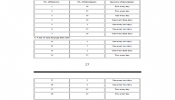Hello,
@J7M
If your goal is to increase you near max strength, then this kind of high repetition training, with very light weight is probably not the best option.
Of course, if one starts from scratch, then even light weights may provide an increase in strength. However, up to a point we reach pretty fast, one is obliged to use heavier weights. As
@North Coast Miller said, if limit strength is the goal, then low repetition heavy weight may work better.
Supplementing this with some exercises at higher rep range is beneficial for metabolic stress. It can increase size (but not necessarily strength) and endurance as well.
Eugene Sandow also has a routine with low repetition and heavy weights. From what I remember, he also stated that as soon as we reach the required number of repetitions, one has to increase the weight and start over. This is a progressive overload system.
I would also add that most of these strongmen were wrestlers, circus guys, gymnasts, etc... For example, B. Pandour also had a wonderful physique and was pretty strong. He claimed building it using 5 to 10 lbs db. It sounds almost impossible as far as "modern science" is concerned. However, he was a former gymnast.
IMHO, I think there is some kind of "marketing" thing: selling a light weight method allows to catch a larger amount of people.
In addition, they also had a very specific diet. Sandow and the other may have found the diet that worked best for them.
I remember an article of Aleks Salkin where he stated that one could do exactly what
@North Coast Miller said:
- low rep for strength
- high rep for hypertrophy
In this case, the high rep was a set of push up close to failure (for chest in this case), performed at the end of the training. This logic can be applied for almost all body part.
Kind regards,
Pet'

